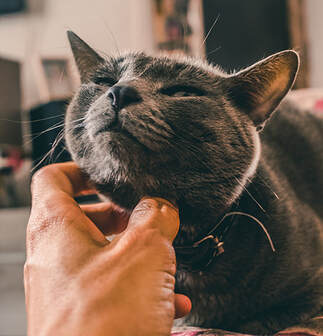 Photo by Bruno Henrique from Pexels
Photo by Bruno Henrique from Pexels Since cats are both predators and prey, they are programmed to perpetually assess their environment. As creatures of habit, territorial and tenacious, they must feel safe rather than sorry before relaxing their guard and revealing their sociable side.
That said, giving your new kitty companion some space before greeting her is key to earning her trust and winning her heart. Why? Because this affords her the opportunity to decide if she feels comfortable enough to interact with you or if it’s best, temporarily at least, for her to keep her distance.
Always allow HER to approach YOU. If she senses that she has a choice, she’s far less likely to run off.
Avoid looking her in the eye. Since a direct stare is considered a challenge in the animal world, use brief, soft glances – much like repeated slow blinks -- to reassure her that you’re not a threat.
To seem less imposing, never stand (read “tower”) over her. Instead either kneel down or sit on the floor. Meant to put her at ease, this should also encourage her to come closer, paw step by paw step, and begin her scent investigation of you.
Because cats rely so heavily on their highly developed sense of smell, you can use this to your mutual advantage. Slowly extend your index finger to see if she’ll venture even closer for that all-important first sniff. This is akin to two cats meeting one another for the first time and “going nose to nose” as each sniffs the other’s unique scent.
If she does, indeed, sniff your finger, pay close attention to what she does next. If she rubs against your finger, this is a friendly sign. If she moves in closer to rub against your arm, it’s an even friendlier sign, showing that she obviously feels comfortable enough to share this almost immediate, more intimate contact with you. But if she sniffs your finger and either stands still or backs away, it means that she’s still not quite sure of you. Resist the impulse to make any further moves in her direction. She may return for a second sniff or she may simply choose – for the moment -- to retreat altogether. If she does, don’t think of this first experience as a failure. By being patient, giving her the choice and not pressuring her, you’ve established that all-important initial bond of trust. Hopefully, she’ll feel more comfortable the second time – or the third -- and engage with you sooner and go farther.
If, on the other hand, you’re actually able to pet your new kitty, don’t push her tolerance level, particularly when she’s just learning to trust you. The same rule applies if she settles down beside you or curls up in your lap. If she decides, at any time, to move away, don’t grab her or try to lure her back. As long as she knows that she’s free to leave, she’ll feel that much more comfortable getting closer to you the next time.









 RSS Feed
RSS Feed